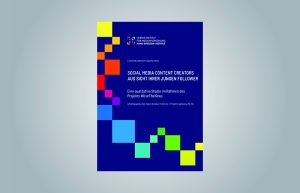Jugendliche und junge Erwachsene folgen gezielt Influencern und anderen Accounts in sozialen Medien, um sich zu unterhalten, zu informieren oder um mitreden zu können. Social Media Content Creators auf Instagram, TikTok und anderen Plattformen erfüllen dabei unterschiedliche Funktionen für verschiedene Nutzungsmotive und tragen wesentlich zur Meinungsbildung bei. Accounts einzelner Persönlichkeiten bieten Orientierung und haben wichtige Identifikations- und Vorbildfunktionen für ihre jungen Follower. Auch die Accounts klassischer Nachrichtenanbieter werden geschätzt und genießen bei jungen Menschen Vertrauen, weil sie als unabhängig und seriös gelten.
 Dies sind Ergebnisse einer Studie des Hamburger Leibniz-Instituts für Medienforschung im Rahmen des Projekts #UseTheNews, das in Kooperation mit der dpa, Verlagen sowie öffentlichen-rechtlichen und privaten Rundfunkanbietern die Nachrichtenkompetenz junger Menschen fördert.
Dies sind Ergebnisse einer Studie des Hamburger Leibniz-Instituts für Medienforschung im Rahmen des Projekts #UseTheNews, das in Kooperation mit der dpa, Verlagen sowie öffentlichen-rechtlichen und privaten Rundfunkanbietern die Nachrichtenkompetenz junger Menschen fördert.
Für die qualitative Studie „Social Media Content Creators aus Sicht ihrer jungen Follower“ wurden Tiefeninterviews mit 14- bis 17-jährigen Jugendlichen und 18- bis 24-jährigen jungen Erwachsenen geführt. Darin wurde gefragt, welchen Accounts sie in sozialen Medien folgen, welche Nutzungsmotive sie damit verknüpfen und wie sie einzelne Akteurinnen und Akteure bewerten.
Vier Account-Typen lassen sich nach Nutzungsmotiven unterscheiden:
- Inhalts-fokussierte themenspezifische Accounts werden zur Unterhaltung und zum Zeitvertreib genutzt.
- Inhalts-fokussierte themenvielfältige Accounts dienen Wissens- und Informationszwecken.
- Personen-fokussierte themenvielfältige Accounts ermöglichen Soziale Nähe & Einblick, Inspiration & Motivation sowie Kommunikation & Integration.
- Bei Personen-fokussierten themenspezifischen Accounts stehen einzelne Persönlichkeiten im Mittelpunkt, denen eine Identifikations- und Vorbildfunktion zugesprochen wird.
Inhalte-fokussierte themenvielfältige und Personen-fokussierte themenspezifische Accounts werden durchaus als relevant für die eigene Meinungsbildung erachtet, da sie Fakten und Hintergrundwissen bieten, um sich eine „fundierte“ und „professionelle“ Meinung zu bilden. Diese Accounts werden als besonders „seriös“ und „vertrauenswürdig“ bewertet.
Bedeutung der Studie für Journalismus und Bildungsinitiativen
Der Begriff „Influencer“ wird von den befragten Jugendlichen und jungen Erwachsenen mit Merkmalen wie Werbefinanzierung und einer thematischen Ausrichtung in den Bereichen Beauty, Mode, Lifestyle und Fitness assoziiert. Influencer werden also nur als eine Teilgruppe unter vielen Akteurinnen und Akteuren in den sozialen Medien wahrgenommen.
„Influencern allgemein eine zu große und zu allgemeine Relevanz zuzuschreiben, ist nicht angebracht. Vielmehr bietet sich für den Journalismus die Chance, sich als unabhängiger und vertrauensvoller Akteur zu platzieren und sich gleichzeitig von werbefinanzierten Inhalten und Persönlichkeiten abzugrenzen“, sagen die Studienautoren Leonie Wunderlich und Sascha Hölig.
Zur Frage nach Chancen und Risiken von Kooperationen mit einzelnen Social Media Content Creators und beliebten Influencern, etwa für Bildungszwecke, raten die Autoren: „Hierbei sollten Persönlichkeiten ausgesucht werden, die ein spezifisches Genre bedienen oder themenspezifisches Wissen vermitteln und daher eine Wissens- und Informationsfunktion erfüllen und als glaubwürdig und vertrauenswürdig gelten“.
Studiendesign: Qualitative Leitfadeninterviews mit Jugendlichen und jungen Erwachsenen
Im Rahmen der Studie wurden halbstrukturierte Leitfadeninterviews mit insgesamt 22 Jugendlichen und jungen Erwachsenen (14 bis 24 Jahre) geführt, die mit Blick auf ihr Geschlecht, ihren Wohnort und ihren formalen Bildungshintergrund gemischt zusammengesetzt waren. In den Interviews, die im Durchschnitte etwas mehr als eine Stunde gedauert haben, wurden individuelle Account-Repertoires der Teilnehmenden erstellt. Außerdem wurden mit Visulisierungshilfen und der Methode des „Lauten Denkens“ über die Nutzungsmotive und Eigenschaften der gefolgten Social Media Content Creator Accounts gesprochen. Transkripte der Interviews sowie weitere Fragebogen- und Memomaterialen haben als Basis für die Auswertung und Analyse der Gespräche gedient.
Über #UseTheNews
Das bundesweite Projekt #UseTheNews geht der Nachrichtennutzung und -kompetenz junger Menschen auf den Grund und entwickelt neue Informations- und Bildungsangebote. In einem News Literacy Lab werden auf Basis der Studienergebnisse neue Nachrichtenangebote konzipiert. Begleitet wird das News Literacy Lab von Journalismus-Experten der Hamburger Hochschule für Angewandte Wissenschaften (HAW). Darüber hinaus werden unter dem Titel Open News Education (ONE) Bildungsangebote, Unterrichtsmaterialien und Fortbildungen für Lehrkräfte entwickelt, um die Vermittlung von Nachrichtenkompetenz in Schulen zu stärken. Initiiert wurde #UseTheNews von der Deutschen Presse-Agentur dpa und der Hamburger Behörde für Kultur und Medien. Unterstützt wird das Projekt von einem Kuratorium aus namhaften Persönlichkeiten aus Medien und Politik.
Wunderlich, Leonie; Hölig, Sascha (2022): Social Media Content Creators aus Sicht ihrer jungen Follower. Eine qualitative Studie im Rahmen des Projekts #UseTheNews. Hamburg: Verlag Hans-Bredow-Institut, Oktober 2022 (Arbeitspapiere des Hans-Bredow-Instituts | Projektergebnisse Nr. 64). DOI: https://doi.org/10.21241/ssoar.81872

